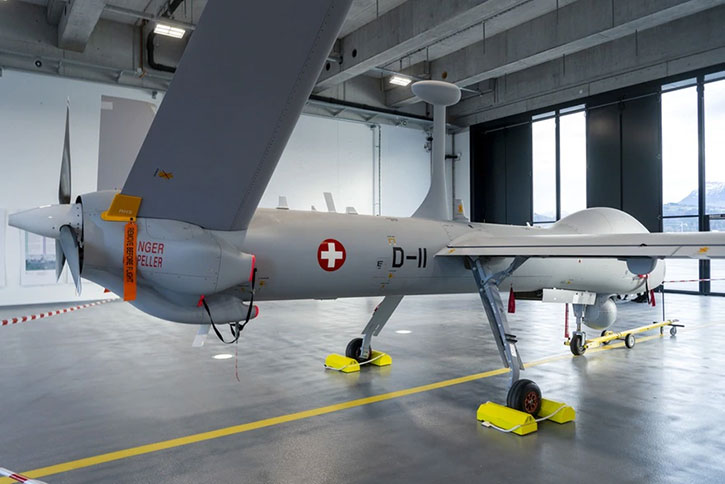Switzerland’s defense ministry (ArmaSwiss) has announced that the first two Elbit Systems Hermes 900HFE drones were delivered to Emmen airfield last week. Two ground stations, communications, logistics, and maintenance equipment were also provided with the drones. The Unmanned Aerial Vehicles (D-11 and D-14) have already been assembled, and they will undergo a functional check before the first flight tests in mid-year. The first group of pilots completed training in Israel in March 2022 and will participate in the flight testing. These drones are part of the six ordered by Switzerland in 2016 under the ADS-15 program, at the cost of CHF250 million (around $256 million at the time).
After completing flight testing and approval activities by the military aviation authority (MAA), they will be handed over to the air force in the second half of the year. Four more UAVs will be delivered by the end of 2023.
The delivery of the drones was delayed after one of the drones crashed in August 2020 during test flights and certification in Israel. The investigation of that crash uncovered a structural problem that caused the tail unit to detach from the fuselage when the drone was subjected to an extreme high-speed maneuver, flying close to its ‘symmetric-flutter boundary.’ The condition caused severe structural oscillations that have led to ‘a very short period and aggressive process’ that caused the tail to detach and crash. Elbit Systems have since solved the problem without any large-scale design changes.

The Swiss certification of the Hermes-900HFE will be based on the comprehensive airworthiness approval process conducted by Israel’s Aviation Authority (IAA) in the past three years, which has led to the first certification of a large drone to fly in civilian airspace. IAA has reciprocal agreements with the European Civil Aviation Authority enabling the European authorities to base part of their evaluation process on the Israeli approval.
This civilian authorization represents an essential milestone in introducing drone activity in Europe. They are required to carry out military missions, including reconnaissance, surveillance, artillery fire coordination, border security missions, or search and rescue over mountain ranges, land, and sea. While some of these tasks are done by small drones or helicopters, the large drones are much more efficient and versatile in carrying large payloads on extended ranges and long endurance. But the drones designed for military missions do not meet airworthiness standards and therefore cannot operate safely in airspace crowded by civilian aviation. To meet the civilian airworthiness and flight safety standards, the design and manufacturing should adhere to the safety standards applied to manned aircraft, with the additional aspects related to their unmanned operation. This version is now called ‘Starliner‘. To comply with airworthiness requirements, the drone is prepared to fly during the day and at night, in adverse weather and icing conditions, and is equipped with sensors and radars to sense, detect and avoid aircraft, other drones, and missiles.





















